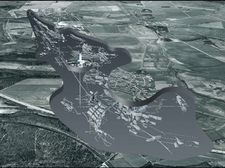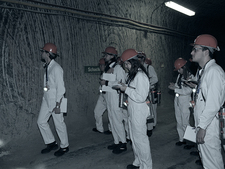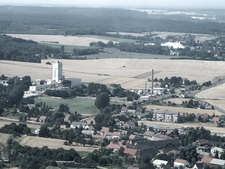Morsleben repository at a glance
The Morsleben repository in Saxony-Anhalt is an over 100-year-old potash and rock salt mine. In World War II the mine served as underground arms production facility and concentration camp subcamp, later on to breed chicken and store toxic waste. Between 1971 and 1991 and from 1994 to 1998, 36,754 cubic metres of low-level and intermediate-level radioactive waste was disposed of. Furthermore, small amounts of radioactive waste were stored intermediately.
The proper and long-term safe enclosure of the waste is still outstanding. This must take into consideration the safety aspects occurring in an ageing mine and must delay and limit the release of the radionuclides contained in the waste to the extent that all protection goals are achieved. The Federal Office for Radiation Protection (BfS) applied for the decommissioning of the Morsleben repository under nuclear law. The plan-approval procedure is currently underway.
The decommissioning concept
The decommissioning concept applied for provides for the backfilling of over 75 per cent of the mine with salt concrete. Since salt concrete has similar chemical and physical characteristics as the salt host rock, it is particularly well suited for this purpose. In the rare event, which needs however still be taken into consideration, that relevant brine volumes enter the repository, 22 special sealing structures will be constructed additionally in the vicinity of the emplacement areas.

![]() Morsleben repository mine openings
Morsleben repository mine openings
Model calculations show that it is possible to decommission the Morsleben repository safely with the decommissioning concept applied for. Correspondingly, no impermissible consequences for man and environment need to be expected in the future. According to current plans, the implementation of the decommissioning measures will take about 15 to 20 years. Due to the current procedural situation of the running plan-approval procedure, the BfS is not in a position to forecast when decommissioning will start.
The nuclear plan-approval procedure
Currently, the nuclear plan-approval procedure according to the Nuclear Licensing Procedure Ordinance (AtVfV) is underway. Key players are the BfS as applicant and the Ministry for Agriculture and Environment of the federal state of Saxony-Anhalt (MLU) as competent licensing authority. Furthermore, the public has to be involved comprehensively in the context of the procedure. The examination of the decommissioning concept applied for by the licensing authority has so far not concluded.
Stabilisation measures 2003 - 2011
In the scope of the so-called prevention against mining hazards in the central part, altogether 27 chambers located in the central part of the Bartensleben mine were backfilled with about 935,000 cubic metres of salt concrete from 2003 to 2011. The objective was to guarantee the mining and work safety in the highly excavated central part also for future decommissioning work and to secure access to the radioactive waste. The stabilisation was achieved in time, so that the Morsleben repository can be safely operated and subsequently decommissioned until the pending nuclear plan-approval procedure will have concluded.
Monitoring of the repository
Comprehensive monitoring measures ensure the current and future safety of the Morsleben repository. Among others, the mining state of the repository mine is monitored. The results gained in the past years show only slight and regular deformation rates below 1 millimetre per year. They do not compromise the repository’s stability.
Furthermore, persons, facilities and the environment are controlled for possible radiation exposures. The results show that neither staff and visitors nor the environment are at risk. The levels are well below the permissible limit values. The existence of the Morsleben repository cannot be detected by measurements in the vicinity.
Public relations
The BfS provides manifold opportunities to share information and engage in dialogue about the Morsleben repository. These opportunities provide an insight into the everyday challenges of operation and the planned decommissioning of the repository. Besides, citizens get the opportunity to comprehend decision-making processes and to express their opinion.

![]() Visitors in the Morsleben repository
Visitors in the Morsleben repository
A significant contribution to the transparent public relations work is the INFO MORSLEBEN which is located in the immediate vicinity of the repository. Visitors can catch up here with the past of the mine, emplacement operations, the present and future works and with the pending plan-approval procedure. A multimedia exhibition with short films, visual aids, exhibits and models provide a comprehensive offer of information.
Additionally, all interested citizens can visit the repository from Monday to Friday. The number of participants is limited to 15 persons. It is necessary to make reservations.
State of 2016.04.26


